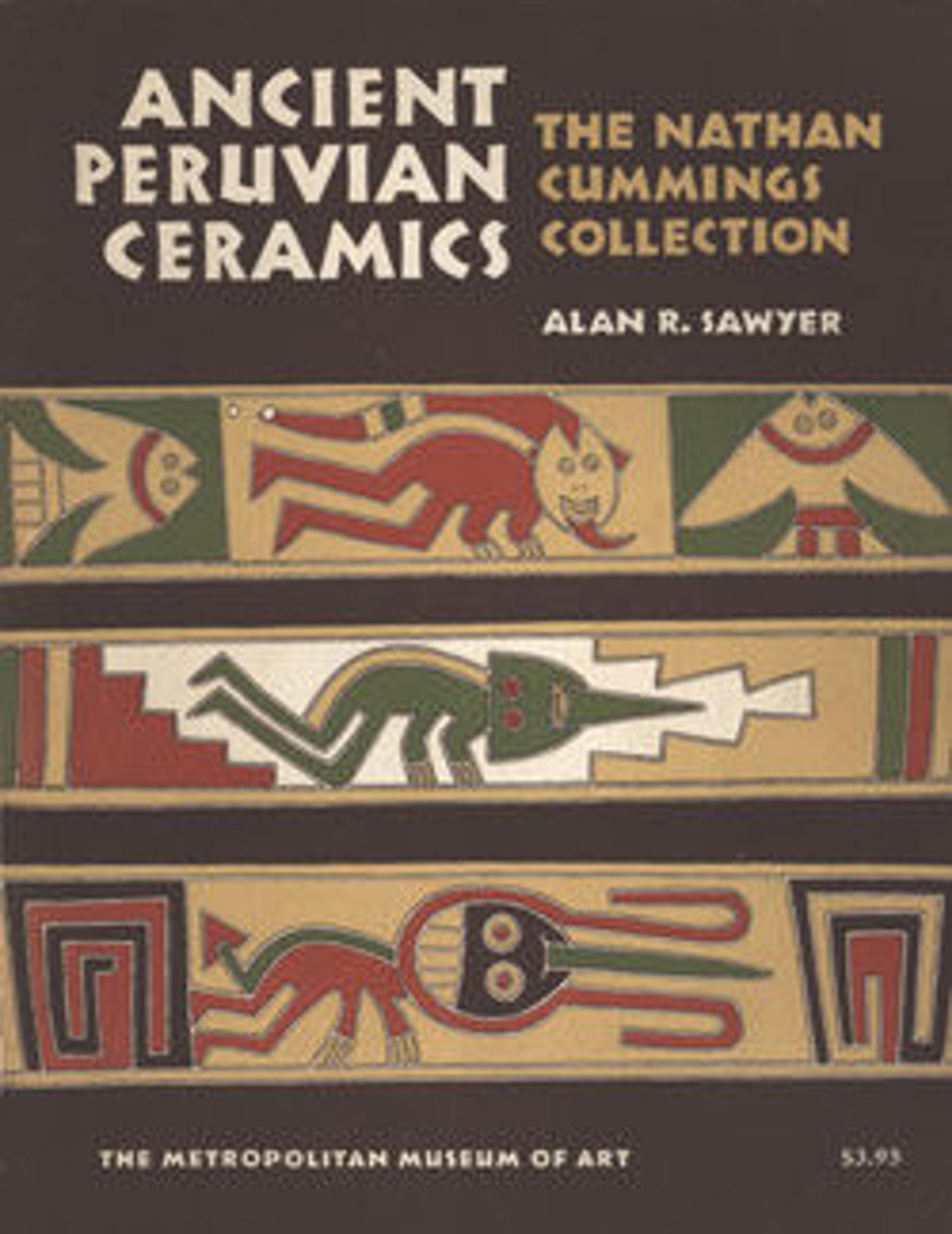Stirrup Spout Bottle with Warrior Figure
This ceramic vessel in the shape of a warrior on bended knee was fabricated by artisans of the Moche culture of Peru’s North Coast. The figure wears battle regalia, including a conical helmet fastened under the chin and featuring a metal crescent projecting upwards; a red-and-white tunic; belt; a necklace with elongated champagne cork-shaped beads; wrist ornaments; and a loin cloth. He carries a mace and a small shield with a design of concentric white and red circles. The darker pigment of his face indicates that he is wearing face paint. The image of a kneeling warrior is often shown in Moche art, but the significance of this position is unclear; are these individuals pledging allegiance to an individual of rank or are they pausing while preparing for battle? As there was no tradition of writing in South America prior to the arrival of Europeans in the sixteenth century, it is difficult to interpret this imagery with precision.
Ceramics of this form are called stirrup spout-vessels—the shape of the spout recalls the stirrup on a horse's saddle—and were a much favored form on Peru's northern coast for about 2,500 years. Although the importance and symbolism of this distinctive shape is puzzling to scholars, the double-branch/single-spout configuration may have prevented evaporation of liquids, and/or may have been convenient for carrying. Early in the first millennium AD, the Moche elaborated stirrup-spout bottles into sculptural shapes depicting a wide range of subjects, including human, animals, and plants worked with a great deal of naturalism. About 500 years later, bottle chambers became predominantly globular, providing large surfaces for painting complex, often multi-figure scenes (Donnan and McClelland, 1999; Lavalle, 1970; see examples in the Met’s collection, including 67.167.1, 1978.412.70, and 64.228.6).
The Moche (also known as the Mochicas) flourished on Peru’s North Coast from AD 200-850, centuries before the rise of the Incas. Over the course of some six centuries the Moche built thriving regional centers from the Nepeña River Valley in the south to perhaps as far north as the Piura River, near the modern border with Ecuador, developing coastal deserts into rich farmlands and drawing upon the abundant maritime resources of the Pacific Ocean’s Humboldt Current. Although scholars do not agree about the nature of Moche political organization—including whether or not they formed a single state—they shared unifying cultural traits such as religious practices (Donnan, 2010).
References and Additional Reading
Donnan, Christopher B, “Moche State Religion.” In New Perspectives on Moche Political Organization, edited by Jeffrey Quilter and Luis Jaime Castillo (Washington D.C.: Dumbarton Oaks Research Library and Collection, 2010), pp. 47-69.
Donnan, Christopher B. and Donna McClelland, Moche Fineline Painting: Its Evolution and Its Artists (Los Angeles: Fowler Museum of Cultural History, University of California, Los Angeles, 1999).
Lavallée, Danièle, Les représentations animales dans la céramique Mochica (Paris: Mémoires de l’Institut d’Ethnologie 4, 1970).
Ceramics of this form are called stirrup spout-vessels—the shape of the spout recalls the stirrup on a horse's saddle—and were a much favored form on Peru's northern coast for about 2,500 years. Although the importance and symbolism of this distinctive shape is puzzling to scholars, the double-branch/single-spout configuration may have prevented evaporation of liquids, and/or may have been convenient for carrying. Early in the first millennium AD, the Moche elaborated stirrup-spout bottles into sculptural shapes depicting a wide range of subjects, including human, animals, and plants worked with a great deal of naturalism. About 500 years later, bottle chambers became predominantly globular, providing large surfaces for painting complex, often multi-figure scenes (Donnan and McClelland, 1999; Lavalle, 1970; see examples in the Met’s collection, including 67.167.1, 1978.412.70, and 64.228.6).
The Moche (also known as the Mochicas) flourished on Peru’s North Coast from AD 200-850, centuries before the rise of the Incas. Over the course of some six centuries the Moche built thriving regional centers from the Nepeña River Valley in the south to perhaps as far north as the Piura River, near the modern border with Ecuador, developing coastal deserts into rich farmlands and drawing upon the abundant maritime resources of the Pacific Ocean’s Humboldt Current. Although scholars do not agree about the nature of Moche political organization—including whether or not they formed a single state—they shared unifying cultural traits such as religious practices (Donnan, 2010).
References and Additional Reading
Donnan, Christopher B, “Moche State Religion.” In New Perspectives on Moche Political Organization, edited by Jeffrey Quilter and Luis Jaime Castillo (Washington D.C.: Dumbarton Oaks Research Library and Collection, 2010), pp. 47-69.
Donnan, Christopher B. and Donna McClelland, Moche Fineline Painting: Its Evolution and Its Artists (Los Angeles: Fowler Museum of Cultural History, University of California, Los Angeles, 1999).
Lavallée, Danièle, Les représentations animales dans la céramique Mochica (Paris: Mémoires de l’Institut d’Ethnologie 4, 1970).
Artwork Details
- Title:Stirrup Spout Bottle with Warrior Figure
- Date:1st–4th century
- Geography:Peru
- Culture:Moche
- Medium:Ceramic, slip
- Dimensions:H. 8 1/2 × W. 6 1/2 × D. 8 1/2 in. (21.6 × 16.5 × 21.6 cm)
- Classification:Ceramics-Containers
- Credit Line:Gift of Mr. and Mrs. Nathan Cummings, 1964
- Object Number:64.228.31
- Curatorial Department: The Michael C. Rockefeller Wing
More Artwork
Research Resources
The Met provides unparalleled resources for research and welcomes an international community of students and scholars. The Met's Open Access API is where creators and researchers can connect to the The Met collection. Open Access data and public domain images are available for unrestricted commercial and noncommercial use without permission or fee.
To request images under copyright and other restrictions, please use this Image Request form.
Feedback
We continue to research and examine historical and cultural context for objects in The Met collection. If you have comments or questions about this object record, please contact us using the form below. The Museum looks forward to receiving your comments.
